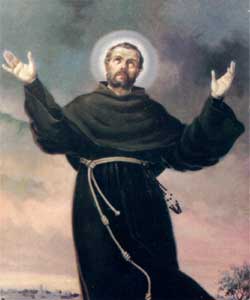Wedding at Cana by Paolo Veronese, 16th century
Each year in the Traditional Liturgy of the Church (1962 Roman Catholic Missal) on the 2nd Sunday after the Epiphany, the Church recalls the Wedding at Cana and Jesus' first public miracle, namely the changing of water into wine at the Wedding Feast of Cana.
And the third day, there was a marriage in Cana of Galilee: and the mother of Jesus was there. And Jesus also was invited, and his disciples, to the marriage. And the wine failing, the mother of Jesus saith to him: They have no wine. And Jesus saith to her: Woman, what is that to me and to thee? my hour is not yet come. His mother saith to the waiters: Whatsoever he shall say to you, do ye.
Now there were set there six waterpots of stone, according to the manner of the purifying of the Jews, containing two or three measures apiece. Jesus saith to them: Fill the waterpots with water. And they filled them up to the brim. And Jesus saith to them: Draw out now, and carry to the chief steward of the feast. And they carried it. And when the chief steward had tasted the water made wine, and knew not whence it was, but the waiters knew who had drawn the water; the chief steward calleth the bridegroom, And saith to him: Every man at first setteth forth good wine, and when men have well drunk, then that which is worse. But thou hast kept the good wine until now.
This beginning of miracles did Jesus in Cana of Galilee; and manifested his glory, and his disciples believed in him.
Jn 2:1-11 (Douay Rheims)
On January 6th of each year the Church celebrates the Epiphany of the Lord, the arrival of the Magi to the Infant Jesus. But that is the merely the first of three epiphany moments, which are all equally remembered in the Traditional Liturgy on the Feast of the Epiphany. Today in the Gospel we focus once more on one of the three primary manifestations of Christ, namely the Miracle in Cana. The other manifestation is recalled yearly as well on January 13rd (Traditional 1962 Liturgy), and this manifestation is the Baptism of Jesus in the River Jordan, at which God the Father calls out from Heaven: "This is my Beloved Son in whom I am well pleased."
We notice that it is Mary who intervenes for the people and says to Jesus, “They have no wine.” In the same regards, Mary intervenes for anyone who asks for her prayers. While there certainly is only one mediator between God and man, Mary is the Mother of God and an intercessor for mankind.St. Albert the Great wrote in Mary, Canice, p. 36: "Immediately next to being God is being the Mother of God." She held a unique role in salvation's history. Jesus Christ redeemed us, but Mary remains the Mother of Jesus and our spiritual mother. She is not equal to God but rather the most glorious person created by God because of her humility, trust in God, and above all, her Immaculate Conception.
Cannon Francis Ripley write in This is the Faith pg. 367: "Because of the inexpressible dignity that is hers, the Catholic Church has from the beginning given Mary the highest form of honor below that reserved for God alone. The Church's practice has always reflected her belief that, provided Mary is not "adored" (which is the unique honor given to God alone), she cannot be honored to excess."
Looking at John 19:27, Jesus says to St. John: "Behold thy mother." Is she literally the mother of John? No, of course not, but she is his spiritual mother - a symbol of Mary becoming the mother of the Faithful. And there should be no objection to her being our spiritual mother.
The Gospel account continues with Jesus responding to Mary: “Woman, what is that to me and to thee? my hour is not yet come" Now here is where the objections come. Most protestants will claim that the usage of woman illustrates the unimportance of Mary. This is completely false! Look to Genesis 3:15 which states, “I will put enmity between you [the serpent] and the woman, and between your offspring and hers; He will strike at your head, while you strike at his heel”. This “enmity” in Genesis 3:15 is not between the man and the serpent but the woman and the serpent. Church teachings are that this is in reference to Mary, the one to come and destroy the serpent because of allowing Our Lord to take flesh within her.
Not sure, yet? Look to Revelations 12:1, which states, "A great sign appeared in the sky, a woman clothed with the sun, with the moon under her feet, and on her head a crown of twelve stars." But, who is this woman in the Book of Revelations? It is Mary, as the Book of Revelations states, the woman gives "...birth to a son, a male child, destined to rule all the nations with an iron rod" (Revelations 12:5). This child was Jesus Christ, and the woman is Mary! So, when we look back at the Wedding Feast of Cana, Jesus is alluding to Mary as the woman promised in Genesis and spoken in Revelations. This is honoring her! Satan is not in a war against Jesus Christ - he is fighting against Mary and us! Satan is nothing compared to the God. He hates us because we have the chance to enter Heaven, but Satan fell from Heaven forever by his rebellion. Satan wants to destroy our salvation, so he hates us all. As Genesis states, the entity is between the serpent and the Woman. All of this theological mystery is part of Jesus' words in the Wedding Feast of Cana.
One can not assume that calling Mary woman is inappropriate or showing of disrespect by applying present-day practices (namely, not calling our own mothers woman) to a different culture from 2,000 years ago.
And, then Jesus Christ says, "My hour is not yet come." What is his hour? His hour is the Cross - the literal three hours that He would spend on the Cross for the world's redemption. As John 12:23 states, "The hour has come for the Son of man to be glorified." So, when Jesus says to His Mother that the Hour has not yet come, He is saying that if He performs a miracle then the road to the Cross has begun! But, Jesus performs the miracle and embarks on a journey to the Cross for love of us. Let us walk with Him in peace and joy this Epiphany Season and all year long.
For more information please see the reflections from "The Church's Year" by Fr. Leonard Goffine on the 2nd Sunday after the Epiphany
For more information please see the reflections from "The Church's Year" by Fr. Leonard Goffine on the 2nd Sunday after the Epiphany














